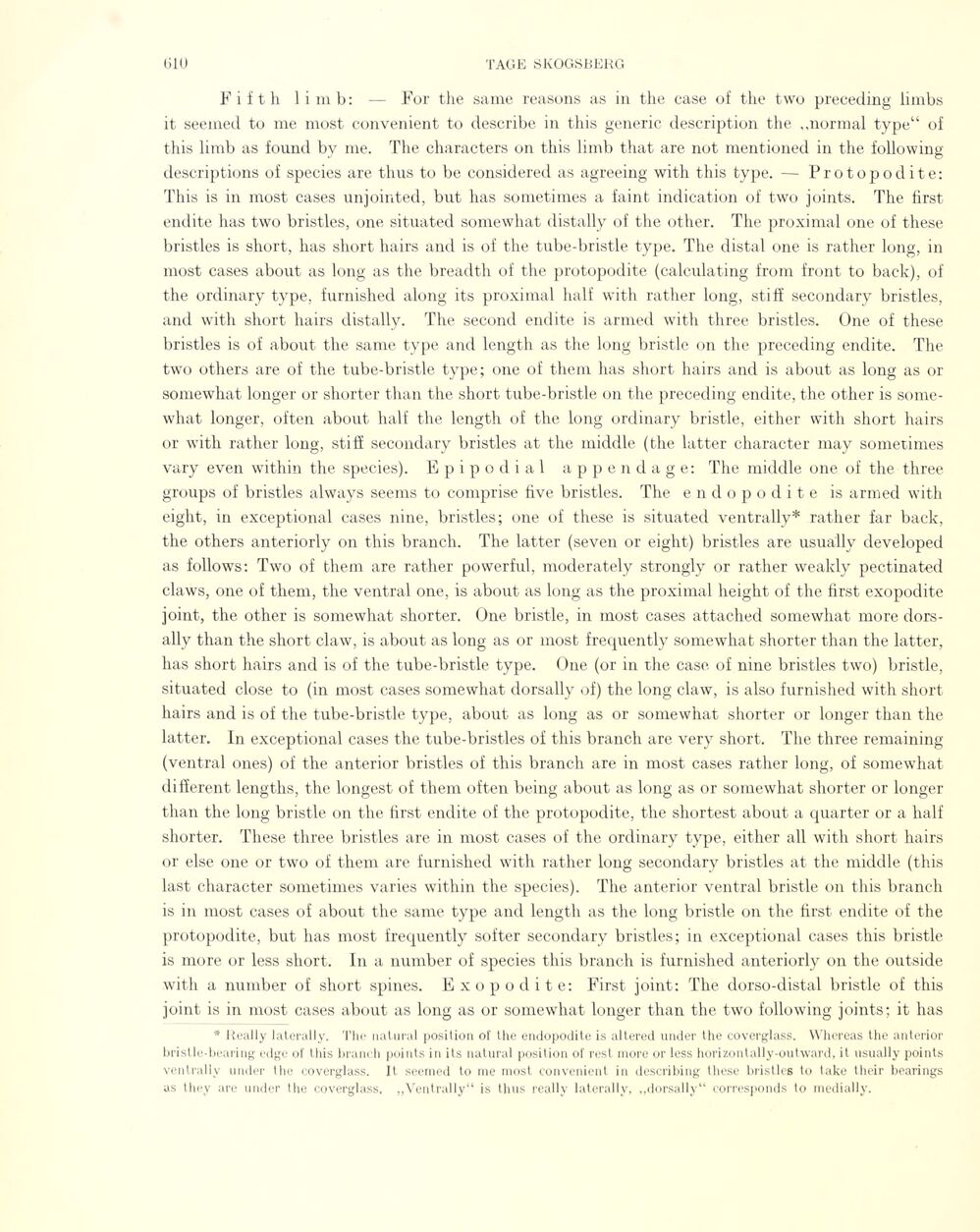
Full resolution (JPEG) - On this page / på denna sida - Sidor ...

<< prev. page << föreg. sida << >> nästa sida >> next page >>
Below is the raw OCR text
from the above scanned image.
Do you see an error? Proofread the page now!
Här nedan syns maskintolkade texten från faksimilbilden ovan.
Ser du något fel? Korrekturläs sidan nu!
This page has never been proofread. / Denna sida har aldrig korrekturlästs.
Fifth li mb: — For the same reasons as in the case of the tvvo preceding limbs
it seemed to me most convenient to describe in this generic description the „normal type“ of
this limb as found by me. The characters on this limb that are not mentioned in the following
descriptions of species are thus to be considered as agreeing with this type. — Protopodite:
This is in most cases unjointed, but has sometimes a faint indication of two joints. The first
endite has two bristles, one situated somewliat distally of the other. The proximal one of these
bristles is short, has short hairs and is of the tube-bristle type. The distal one is rather long, in
most cases about as long as the breadth of the protopodite (calculating from front to back), of
the ordinary type, furnished along its proximal half with rather long, sti ff secondary bristles,
and with short hairs distally. The second endite is armed with three bristles. One of these
bristles is of about the same type and length as the long bristle on the preceding endite. The
two others are of the tube-bristle type; one of them has short hairs and is about as long as or
somewhat longer or shorter than the short tube-bristle on the preceding endite, the other is
some-wliat longer, often about half the length of the long ordinary bristle, either with short hairs
or with rather long, sti ff secondary bristles at the middle (the latter character may sometimes
vary even within the species). Epipodial appendage: The middle one of the three
groups of bristles always seems to comprise five bristles. The endopodite is armed with
eight, in exceptional cases nine, bristles; one of these is situated ventrally* rather far back,
the others anteriorly on this branch. The latter (seven or eight) bristles are usually developed
as follows: Two of them are rather powerful, moderately strongly or rather weakly pectinated
claws, one of them, the ventral one, is about as long as the proximal height of the Erst exopodite
joint, the other is somewhat shorter. One bristle, in most cases attached somewhat more
dorsally than the short claw, is about as long as or most frequently somewhat shorter than the latter,
has short hairs and is of the tube-bristle type. One (or in the case of nine bristles two) bristle,
situated close to (in most cases somewhat dorsally of) the long claw, is also furnished with short
hairs and is of the tube-bristle type, about as long as or somewhat shorter or longer than the
latter. In exceptional cases the tube-bristles of this branch are very short. The three remaining
(ventral ones) of the anterior bristles of this branch are in most cases rather long, of somewhat
different lengths, the longest of them often being about as long as or somewhat shorter or longer
than the long bristle on the hrst endite of the protopodite, the shortest about a quarter or a half
shorter. These three bristles are in most cases of the ordinary type, either all with short hairs
or else one or two of them are furnished with rather long secondary bristles at the middle (this
last character sometimes varies within the species). The anterior ventral bristle on this branch
is in most cases of about the same type and length as the long bristle on the first endite of the
protopodite, but has most frequently softer secondary bristles; in exceptional cases this bristle
is more or less short. In a number of species this branch is furnished anteriorly on the outside
with a number of short spines. Exopodite: First joint: The dorso-distal bristle of this
joint is in most cases about as long as or somewhat longer than the two following joints; it has
* Really laterally. The natural position of the endopodite is altered under the coverglass. Whereas the anterior
bristle-bearing edge of this branch points in its natural position of rest more or less horizontally-outward, it usually points
ventrally under the coverglass. It seemed to me most convenient in describing these bristles to take their bearings
as they are under the coverglass. „Ventrally“ is thus really laterally, „dorsally“ corresponds to medially.
<< prev. page << föreg. sida << >> nästa sida >> next page >>